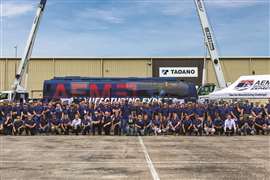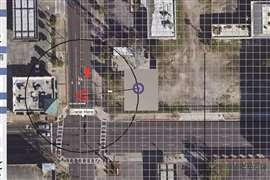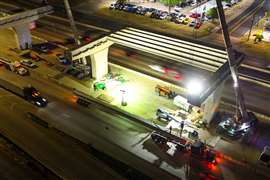North America’s latest specialized transportation projects
23 November 2021
When it comes to the transport of oversized loads and specialty equipment, the planning and execution process is no small feat. ACT surveyed some of the leading specialized transportation companies for information and snapshots of their latest heavy haul projects. From traversing through tropical storms to moving antique yachts, these industry titans completed their unique projects safely and successfully.
Rain, rain go away
All projects have milestones, but little did Northwest Crane Company and its client know that a recently completed transportation project would begin with a hurricane and end with a tropical storm. However, despite nature’s seeming best efforts to disrupt the critical delivery, Northwest completed the multi-phase transportation and offload project of a 472,00-pound process vessel safely and on schedule.
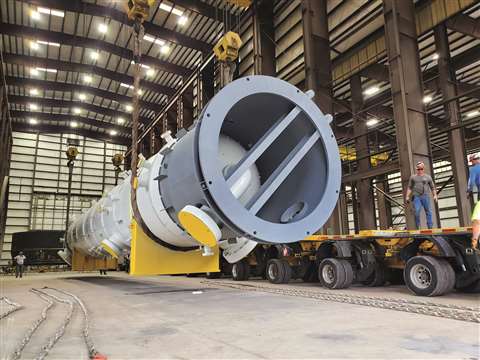 During the immediate aftermath of Hurricane Ida, Northwest Crane Company rolled a process vessel onto a 180-foot by 54-foot by 12.5-foot deck barge using a 14-line Goldhofer THP-DC dual lane transporter.
During the immediate aftermath of Hurricane Ida, Northwest Crane Company rolled a process vessel onto a 180-foot by 54-foot by 12.5-foot deck barge using a 14-line Goldhofer THP-DC dual lane transporter.
Originating in Iuka, MS during the immediate aftermath of Hurricane Ida, the process vessel was rolled onto a 180-foot by 54-foot by 12.5-foot deck barge by Northwest personnel using a 14-line Goldhofer THP-DC dual lane transporter. Soon after, the loaded barge began its journey south and west to the Port of Victoria, TX. Along the way, close coordination and daily planning updates were required to navigate the numerous lock closures that had nearly closed off all access to the Intracoastal Waterway system in the vicinity of New Orleans, LA.
Once the New Orleans area was safely traversed, it seemed the remaining barge transit would be smooth sailing. However, as the loaded barge neared its destination, Tropical Storm Nicholas was bearing down on the Texas coast with forecasts predicting landfall in the exact vicinity of the barge and critical cargo. Fortunately, a safe and secure fleeting area provided protection from any storm impacts and the barge was able to proceed to the Port of Victoria, TX after the U.S. Coast Guard issued the all-clear for the Victoria barge channel.
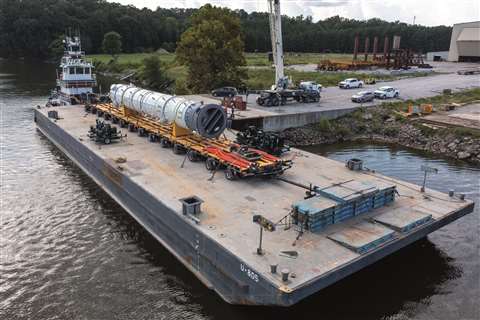 Northwest Crane navigated a process vessel between a hurricane and a tropical storm.
Northwest Crane navigated a process vessel between a hurricane and a tropical storm.
Upon arrival at the Port of Victoria, Northwest personnel safely rolled off the loaded 14-line Goldhofer THP-DC dual lane transporter and then immediately navigated an extremely tight 90-degree term which tested the skills and capabilities of personnel and equipment. However, due to Northwest’s meticulous advance planning, the level of difficulty was a known factor and the tedious operation to get the 812,000-pound gross weight transporter onto route was completed safely and without incident, the company said.
After departing the Port of Victoria, the project went like clockwork with the 1,100-mile permitted route being covered in five days. Upon arrival at the delivery location in the Texas panhandle, Northwest personnel employed two 550-ton capacity LTM 1450-8.1 all-terrain cranes to safely offload the process vessel, rotate the vessel to the correct orientation for vertical lifting at a later date, and place the vessel onto the client’s staging foundations.
Against the clock
To avoid potential power outages, a transformer needed to make it from a rail siding in Cornelius, OR, to a substation in Sherwood within two weeks. Between permit and route challenges and an ever-tightening time frame, the Omega Morgan specialized transportation team worked efficiently to make a safe and timely delivery.
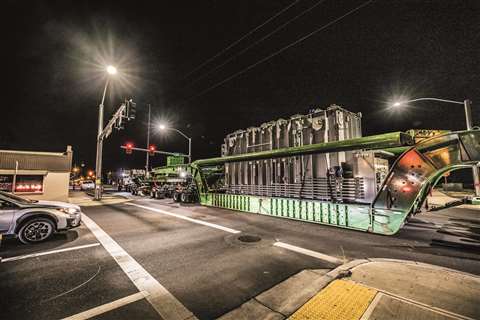 Omega Morgan was tasked with the transport of a transformer measuring 33 feet long by 11 feet wide by 16 feet high and weighed 319,670 pounds.
Omega Morgan was tasked with the transport of a transformer measuring 33 feet long by 11 feet wide by 16 feet high and weighed 319,670 pounds.
When the extreme summer heat damaged a transformer at a substation in Sherwood, the company’s Portland-based specialized transportation crew was called into action. An electrical utility company in the process of expansion had initially contracted with Omega Morgan to transport a new transformer to a storage facility in Hillsboro. But with an emergency at hand, the specialized transportation team worked quickly to reroute the new unit to replace the damaged transformer.
The new transformer was already aboard the railway to Cornelius when the team learned of the damaged unit. With limited time, Omega Morgan simultaneously searched for available rail and trucking routes. Planning this transportation job would typically take two months. However, as the client and the Sherwood community faced potential power outages in the middle of summer, the specialized transportation team found a way to execute with the same level of care and precision in a quarter of the time.
“In this industry, you learn to work with Murphy’s Law, especially when you are up against a time constraint. Our initial plan involved the rail company diverting the railcar closer to the Sherwood area,” said Erik Zander, chief operating officer, Omega Morgan. “When clearance to the necessary rail spur was unavailable within the required time frame, moving the transformer by truck became the only option After searching for a viable route and submitting an application, the Oregon Department of Transportation (ODOT) denied our first permit request due to a weight-deficient bridge. Now with even less time available, we had to look for an alternate route.”
The company’s specialized transport crews spent several nights surveying viable options that would allow a 17-foot clearance. Scheduling necessary wire lifting and tree trimming along the final route on short notice only increased the pressure to have this latest plan approved in time. Fortunately, ODOT worked closely with the specialized transportation team to expedite the process.
The transformer itself measured 33 feet long by 11 feet wide by 16 feet high and weighed 319,670 pounds. Transport required a dual lane perimeter deck trailer with 12 8-tire axles – due to the height and weight – plus a Kenworth C500 in the front to pull and a Kenworth T800 in the back to push. The Omega Morgan specialized transportation crew maneuvered the 96-wheeler into position at a nearby rail siding and loaded the transformer onto the trailer.
That evening when there was less traffic on the route, the team operating the trailer was accompanied by four Omega Morgan pilot cars – two in the front and two in the back – and a bucket truck from a local utility provider to help maneuver the transformer under wires and low hanging traffic signals. Arriving at the substation in Sherwood, the crew offloaded the transformer onto a temporary pad. A few days later, when the permanent pad was ready to receive the transformer, the team completed the move.
Safe and sound
In mid-October, Daily Express safely delivered the historic antique yacht, Chief Uncas, originally built in 1912 for Adolphus Busch to Wrightsville, PA. The company first received a call from the Susquehanna National Heritage Area (SNHA) to move the boat almost a year ago. Daily Express has a reputation for safely moving historic items for multiple historical organizations in both York and Lancaster Counties in Pennsylvania, and where SNHA is headquartered.
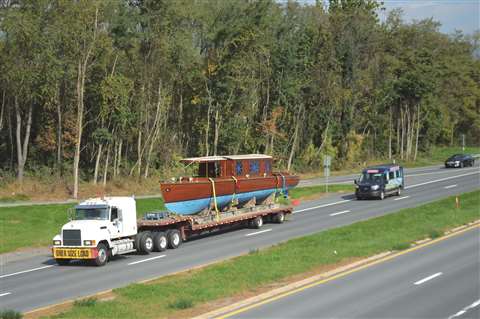 On October 16 2021, Daily Express safely delivered a historic antique yacht, originally built in 1912 for Adolphus Busch to Wrightsville, PA.
On October 16 2021, Daily Express safely delivered a historic antique yacht, originally built in 1912 for Adolphus Busch to Wrightsville, PA.
SNHA’s mission is to connect people to the Susquehanna River which starts in Cooperstown NY and ends in the Chesapeake Bay. The Chief Uncas was also located on Lake Otsego in Cooperstown at the Susquehanna River’s headwaters making it the ideal vehicle to meet the organizations mission. With boat dimensions of 55 feet long by 10 feet wide by 12 feet high and clocking in at 15 tons, this move presented many logistical challenges since it was located at a marina with very tight access and turning radius issues. Multiple on-site visits with SNHA and the Daily Express team determined the best course of action to safely transport a 109-year-old wooden boat.
“Daily Express is heavily involved in the transport of historic railroad equipment throughout the United States and this move was the second oldest piece we have moved, so the safety of the boat was paramount,” said Mark S. Eyer, vice president of operations, Daily Express. “Route evaluations found that a 53-foot long step deck trailer was the safest option as a stretch lowboy would be too long to make specific turns on the route, and the step deck trailer’s ability to spread the axles would result in a shorter turning radius as well, which was critical.”
Keeping as much of the boat supported on a trailer floor was another factor given its historic significance. The overall dimensions of the loaded tractor/trailer were 90 feet long by 10 feet wide by 14 feet 11 inches high loaded with a 10-foot rear overhang. Daily Express arranged the crane loading of the boat as well and brought the crane company into the very first meetings to determine how to get the boat from its location for over-the-road transport. It was determined a 70-ton crane was needed to reach and also safely load the boat for the truck to have access to back out of the marina up a hill.
Extensive dialog with the NYS DOT Central Permit Office and NY District 2 resulted in the approval of a route that would provide sufficient turning radius for the boat and the rear overhang along with a loaded height of 14 feet 11 inches. On the move date, all went well, and the planning resulted in no unexpected transport issues. Loading the Chief Uncas on the shortest possible trailer enabled Daily Express to safely navigate many turns in small towns on the route. Once the boat was loaded onto the tractor/trailer and the loaded dimensions were measured and verified, the driver and the two escorts then resurveyed the permitted route in New York to verify all the vertical clearances of bridges, trees and wires on the route, while checking turning radius. Following that final route evaluation, the Daily Express team departed Cooperstown NY with the Chief Uncas for Wrightsville PA and arriving safely the following day.
Transformer transfer
Buckingham Heavy Transport provided the logistics and transportation for two 488,800-pound transformers from the port in New Orleans to a new power substation in the hills of central West Virginia. The transformers were too large to move by rail, so Buckingham met the ship at the port and coordinated the transfer of the transformers to a barge for travel up the Ohio River. At the landing, Buckingham’s team used barge ramps and 12 lines of Goldhofer PST/SL-E to unload the transformers and haul them several miles down the road to a staging area.
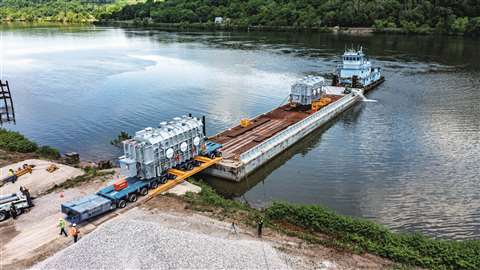 Buckingham Heavy Transport provided the logistics and transportation for two 488,800-pound transformers from the port in New Orleans to a new power substation in the hills of central West Virginia.
Buckingham Heavy Transport provided the logistics and transportation for two 488,800-pound transformers from the port in New Orleans to a new power substation in the hills of central West Virginia.
The next leg of the transport was at night. This section of the route had many low overhead wires, a failed bridge where Buckingham used bridge jumpers and several miles of traveling the wrong way on the interstate. The team utilized a custom 36-axle dual-lane trailer made up of hydraulic dollies programmed with Buckingham SmartSteer technology, which allowed them to distribute the weight while still maneuvering tight corners in a self-propelled mode.
After that, Buckingham had 55 miles of fairly straightforward divided two-lane highway to navigate. The team put the transporter into tow mode and used two pull trucks and two push trucks for additional torque and braking power on the climbs and long grades of the hilly terrain.
After exiting the divided highway, the team transloaded back to the Goldhofer PST/SL-E for the final miles to the substation, as the narrow back roads left little clearance and were too winding to accommodate the dual-lane trailer. The ¾-mile gravel driveway to the site was also winding and steep. A local contractor assisted with a CAT D-9 dozer.
In the substation, the transformer was unloaded to its foundation pad using a Buckingham jack and slide system while another crew hauled the dual-lane trailer back to the staging area to load the second transformer and prepare for the second move. The same procedure was followed for the second transformer.
Prime power
Tradelossa recently hauled a 245-ton transformer from the northern state of Nuevo León, Mexico to one of the most important wind farms in the state of Coahuila, Mexico.
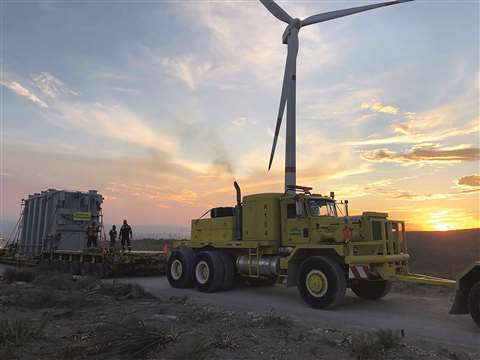 The Tradelossa team designated six Prime Movers to perform the titanic task of moving uphill 245 tons throughout 9.3 miles of both irregular and steep terrain.
The Tradelossa team designated six Prime Movers to perform the titanic task of moving uphill 245 tons throughout 9.3 miles of both irregular and steep terrain.
In April of 2021, Tradelossa was asked to store the transformer at its facility in Apodaca, Nuevo Leon. The transformer measured 34 feet long, 13.4 feet wide, 17 feet high and had a total weight of 245 tons.
Tradelossa’s team made multiple visits to the wind farm to determine the right route. It required preparing the terrain at site and implementing multiple land and road modifications within the wind farm to prepare for the arrival of the transformer. Other tasks included permitting, scheduling and preparing various rigging operations.
The component was transported using a 15-foot 12-axle + deck hydraulic configuration with six axles on the front of the deck and six axles on the back. This configuration allowed the team to safely perform the full transportation of the transformer. During a previous visit at the site, the Tradelossa engineering team realized that to haul the transformer through the wind farm, it had to pass through 9.3 miles of steep terrain.
The Tradelossa team designated six Prime Movers for this sole project to perform the task of moving uphill 245 tons throughout 9.3 miles of both irregular and steep terrain. Once the cargo arrived at its designated point, the rigging team carefully unloaded it and prepared it for installation.
With about 186 miles traveled, all services and operations were executed in three-and-a-half days.
Sarens was commissioned by Kazakhstan Petrochemical Industries (KPI) to offload and transport 37 oversized tanks from the KCOI port to the Karabatan Integrated Gas Chemical Complex.
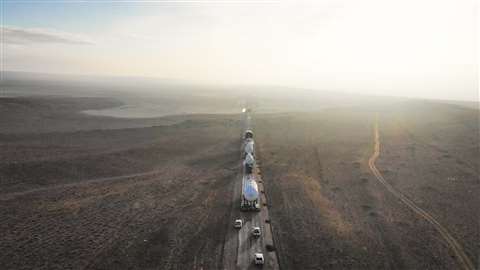
The Karabatan Integrated Gas Chemical Complex, located 20.5 miles north-east of Atyrau and around 5.6 miles north of Karabatan station, is planned to be operational by the second quarter of 2021. Once completed, the project aims at release of export-oriented products with high added value and polymer production for industrial diversification.
The team had to arrange for permissions and approvals from authorities of two regions, including the power companies, traffic police and local civic authorities. The CC4000 available at the KCOI port was used to offload the tanks. Sarens deployed 126 axle-lines and 8 prime movers for the transportation of the oversized loads.
The maximum height of the loads were 32.8 feet with the trailer and the maximum weight was 250-tons without the trailer. The transport was completed in seven continuous trips by a crew of 35 that tackled difficult weather conditions including heavy winds, slippery roads and snow.
STAY CONNECTED


Receive the information you need when you need it through our world-leading magazines, newsletters and daily briefings.
CONNECT WITH THE TEAM










